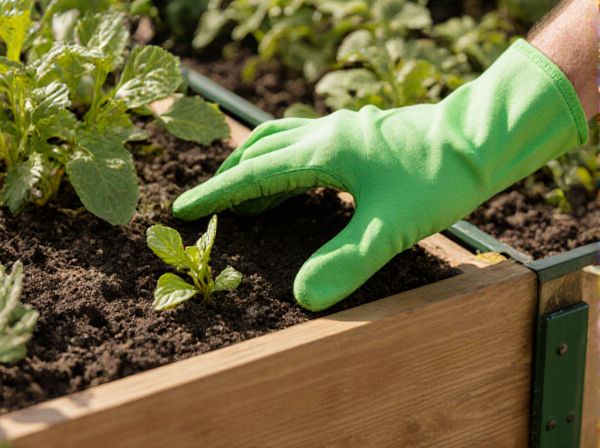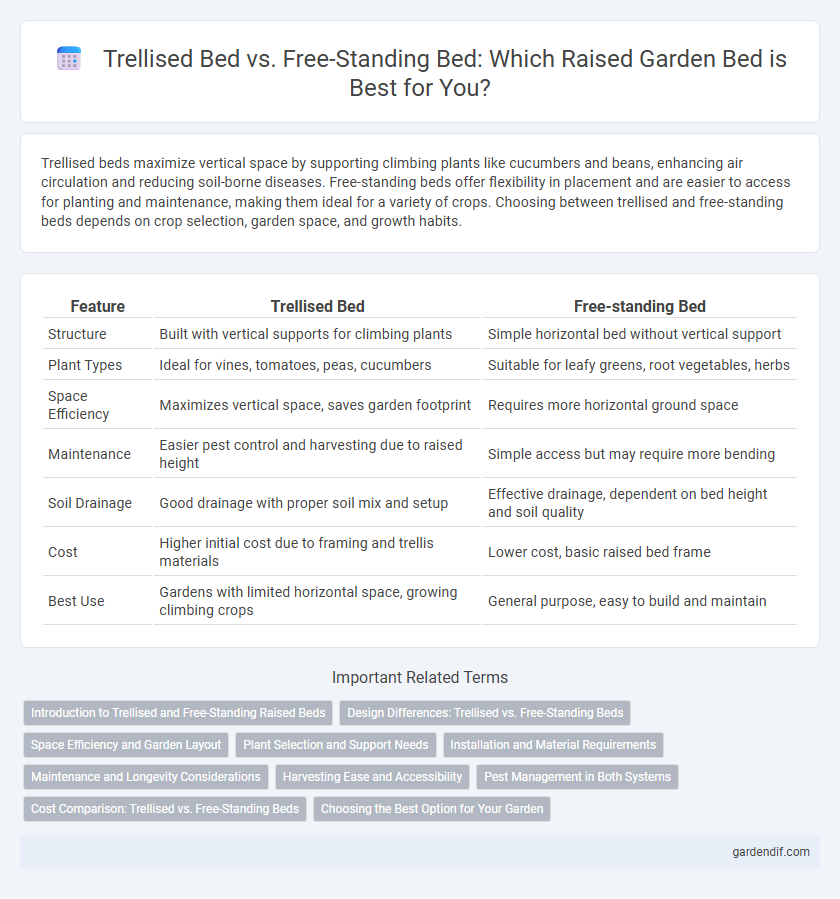
Trellised bed vs Free-standing bed Illustration
Trellised beds maximize vertical space by supporting climbing plants like cucumbers and beans, enhancing air circulation and reducing soil-borne diseases. Free-standing beds offer flexibility in placement and are easier to access for planting and maintenance, making them ideal for a variety of crops. Choosing between trellised and free-standing beds depends on crop selection, garden space, and growth habits.
Table of Comparison
| Feature | Trellised Bed | Free-standing Bed |
|---|---|---|
| Structure | Built with vertical supports for climbing plants | Simple horizontal bed without vertical support |
| Plant Types | Ideal for vines, tomatoes, peas, cucumbers | Suitable for leafy greens, root vegetables, herbs |
| Space Efficiency | Maximizes vertical space, saves garden footprint | Requires more horizontal ground space |
| Maintenance | Easier pest control and harvesting due to raised height | Simple access but may require more bending |
| Soil Drainage | Good drainage with proper soil mix and setup | Effective drainage, dependent on bed height and soil quality |
| Cost | Higher initial cost due to framing and trellis materials | Lower cost, basic raised bed frame |
| Best Use | Gardens with limited horizontal space, growing climbing crops | General purpose, easy to build and maintain |
Introduction to Trellised and Free-Standing Raised Beds
Trellised raised beds incorporate vertical structures such as lattices or frames to support climbing plants, maximizing space and improving air circulation. Free-standing raised beds, by contrast, are standalone containers that provide controlled soil conditions without built-in vertical supports. Both systems enhance garden efficiency but cater to different plant needs and spatial constraints.
Design Differences: Trellised vs. Free-Standing Beds
Trellised raised beds incorporate vertical support structures that allow climbing plants like tomatoes and beans to grow upwards, maximizing space and improving air circulation. Free-standing raised beds lack built-in vertical elements, providing more open horizontal planting area suitable for root vegetables and sprawling plants. The design of trellised beds enhances plant density and accessibility, while free-standing beds offer greater flexibility in layout and crop variety.
Space Efficiency and Garden Layout
Trellised beds maximize vertical space by supporting climbing plants, allowing gardeners to grow more crops in smaller footprints compared to free-standing beds. This vertical growth optimizes garden layout by freeing ground area for additional plantings or pathways, enhancing overall space efficiency. In contrast, free-standing beds require more horizontal space, limiting crop density and making efficient use of garden area more challenging.
Plant Selection and Support Needs
Trellised beds are ideal for climbing plants like tomatoes, beans, and cucumbers that require vertical support to maximize space and improve air circulation. Free-standing beds suit low-growing or sprawling plants such as lettuce, herbs, and root vegetables that do not need structural support. Choosing the right bed type based on plant support needs enhances growth efficiency and crop yield.
Installation and Material Requirements
Trellised raised beds require sturdy materials such as pressure-treated wood or metal frames to support vertical growth structures, along with climbing supports like wire mesh or lattice panels, increasing installation complexity and costs. Free-standing raised beds demand simpler construction with durable wood, composite, or stone materials and typically need only perimeter framing with no additional supports, resulting in quicker and easier installation. Both options benefit from weather-resistant materials, but trellised beds necessitate careful planning for secure anchoring to withstand plant weight and wind pressure.
Maintenance and Longevity Considerations
Trellised beds require regular inspection and upkeep of support structures to prevent damage from plant growth and weather exposure, which can affect their longevity. Free-standing beds demand less structural maintenance but may need more frequent soil replenishment and protection against erosion or pests to maintain productivity. Choosing between the two depends on balancing the commitment to structural care with soil health management for sustained garden performance.
Harvesting Ease and Accessibility
Trellised raised beds enhance harvesting ease by allowing vertical growth, making fruits and vegetables more visible and accessible at eye level. Free-standing beds offer straightforward access on all sides, ideal for gardeners needing unobstructed reach for harvesting. Both designs improve accessibility but trellised beds optimize space and reduce bending, while free-standing beds provide flexibility in crop arrangement and ease of maintenance.
Pest Management in Both Systems
Trellised beds improve pest management by promoting better air circulation and reducing foliage contact with soil, which helps minimize fungal diseases and soil-borne pests. Free-standing beds are more accessible for routine inspections and targeted pest control applications, enabling timely intervention to prevent infestations. Both systems benefit from integrated pest management practices, but trellised beds offer a natural barrier that may reduce pest habitat and improve crop health.
Cost Comparison: Trellised vs. Free-Standing Beds
Trellised raised beds generally incur higher initial costs due to the added expense of materials like wood, metal, or plastic for the trellis structure, compared to free-standing beds which require only the frame and soil. Maintenance costs for trellised beds can be higher if the trellis needs repairs or replacement, while free-standing beds typically involve lower upkeep expenses. Overall, free-standing beds present a more budget-friendly option for gardeners prioritizing cost efficiency.
Choosing the Best Option for Your Garden
Trellised raised beds maximize vertical space by supporting climbing plants like peas, beans, or tomatoes, boosting yield in small gardens. Free-standing raised beds offer more flexibility for diverse crops and easier access for maintenance and harvesting, ideal for gardeners prioritizing convenience. Selecting the best option depends on garden size, plant types, and space utilization goals to optimize growth and productivity.
Trellised bed vs Free-standing bed Infographic

 gardendif.com
gardendif.com